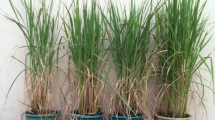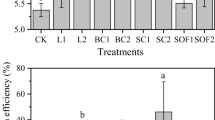Abstract
Phytoextraction is a promising technique to remove cadmium (Cd) from contaminated soils. In this research, the two different Cd accumulation rice lines of Lu527-8 (the high Cd accumulating rice line) and Lu527-4 (the normal rice line) were grown in soils with different Cd treatments (0, 5, 10, and 20 mg kg−1 soil) to evaluate Cd accumulation characteristics and Cd removal potentials. When the concentration of Cd in soil increased, Lu527-8 showed less symptoms of phytotoxicity when compared to Lu527-4. Furthermore, Lu527-8 demonstrated greater shoot Cd accumulation (321.17–964.95 mg plant−1) than Lu527-4 (50.37–201.66 μg plant−1) at the jointing and filling stages. The soil available Cd content of Lu527-8 significantly decreased by 26.92–38.97 and 27.77–63.44 % at the jointing and filling stages, respectively. Meanwhile, the total Cd content in soil also reduced by 11.64–46.75 and 21.41–54.11 % at jointing and filling stages, respectively. When the Cd concentration in soil was 20 mg kg−1, the Cd extraction rate in shoots of Lu527-8 reached 2.12 and 2.85 % which increased 10.60 and 6.48 times compared with that of Lu527-4 at the jointing and filling stages, respectively. In conclusion, this study demonstrates that Lu527-8 shows great abilities of Cd accumulation and Cd removal potential from contaminated soils with different Cd treatments and it is a promising species for phytoextraction of Cd-contaminated soils.



Similar content being viewed by others

References
Adokoh CK, Obodai EA, Essumang DK, Serfor-Armah Y, Nyarko BJB, Asabere-Ameyaw A (2011) Statistical evaluation of environmental contamination, distribution and source assessment of heavy metals (aluminum, arsenic, cadmium, and mercury) in some lagoons and an estuary along the coastal belt of Ghana. Arch Environ Contam Toxicol 61:389–400
Ahmad P, Sarwat M, Bhat NA, Wani MR, Kazi AG, Tran LS (2015) Alleviation of cadmium toxicity in Brassica juncea L. (Czern. & Coss.) by calcium application involves various physiological and biochemical strategies. PLoS One 10:1–17
Ali H, Khan E, Sajad MA (2013) Phytoremediation of heavy metals—concepts and applications. Chemosphere 91:869–881
Arao T, Ae N (2003) Genotypic variations in cadmium levels of rice grain. Soil Sci Plant Nutr 49:473–479
Bu-Olayan AH, Thomas BV (2009) Translocation and bioaccumulation of trace metals in desert plants of Kuwait Governorates. Res J Environ Sci 3:581–587
Gill SS, Khan NA, Tuteja N (2011) Differential cadmium stress tolerance in five Indian mustard (Brassica juncea L.) cultivars: an evaluation of the role of antioxidant machinery. Plant Signal Behav 6:293–300
Goswami S, Das S (2015) A study on cadmium phytoremediation potential of Indian mustard, Brassica juncea. Int J Phytoremediation 17:583–588
Ibaraki T, Kuroyanagi N, Murakami M (2009) Practical phytoextraction in cadmium-polluted paddy fields using a high cadmium accumulating rice plant cultured by early drainage of irrigation water. Soil Sci Plant Nutr 55:421–427
Ishikawa S, Noriharu AE, Murakami M, Wagatsuma T (2006) Is Brassica juncea a suitable plant for phytoremediation of cadmium in soils with moderately low cadmium contamination?—possibility of using other plant species for Cd-phytoextraction. Soil Sci Plant Nutr 52:32–42
Ji P, Sun T, Song Y, Ackland ML, Liu Y (2011) Strategies for enhancing the phytoremediation of cadmium-contaminated agricultural soils by Solanum nigrum L. Environ Pollut 159:762–768
Leitenmaier B, Küpper H (2011) Cadmium uptake and sequestration kinetics in individual leaf cell protoplasts of the Cd/Zn hyperaccumulator Thlaspi caerulescens. Plant Cell Environ 34:208–219
Liu W, Liang L, Zhang X, Zhou Q (2014) Cultivar variations in cadmium and lead accumulation and distribution among 30 wheat (Triticum aestivum L.) cultivars. Environ Sci Pollut Res 22:8432–8441
Liu X, Tian F, **e Y, Ji X (2015) Control effects of Tianshifu soil conditioners on Cd contamination in paddy fields of Hunan Province. Agric Sci Technol 16:1447–1451
Marques AP, Moreira H, Franco AR, Rangel AO, Castro PM (2013) Inoculating Helianthus annuus (sunflower) grown in zinc and cadmium contaminated soils with plant growth promoting bacteria—effects on phytoremediation strategies. Chemosphere 92:74–83
Masakorala K, Yao J, Guo H, Chandankere R, Wang J, Cai M, Liu HJ, Choi MM (2013) Phytotoxicity of long-term total petroleum hydrocarbon-contaminated soil—a comparative and combined approach. Water Air Soil Pollut 224:1–12
McGrath SP, Lombi E, Gray CW, Caille N, Dunham SJ, Zhao FJ (2006) Field evaluation of Cd and Zn phytoextraction potential by the hyperaccumulators Thlaspi caerulescens and Arabidopsis halleri. Environ Pollut 141:115–125
Murakami M, Ae N, Ishikawa S (2007) Phytoextraction of cadmium by rice (Oryza sativa L.), soybean (Glycine max (L.) Merr.), and maize (Zea mays L.). Environ Pollut 145:96–103
Murakami M, Ae N, Ishikawa S, Ibaraki T, Ito M (2008) Phytoextraction by a high-Cd-accumulating rice: reduction of Cd content of soybean seeds. Environ Sci Technol 42:6167–6172
Murakami M, Nakagawa F, Ae N, Ito M, Arao T (2009) Phytoextraction by rice capable of accumulating Cd at high levels: reduction of Cd content of rice grain. Environ Sci Technol 43:5878–5883
Murakami M, Arao T, Ae N, Nakagawa F, Honma T, Ibaraki T, Ito M, Taniguchi A (2010) Phytoextraction of Cd polluted paddy fields by rice [Oryza sativa] capable of accumulating Cd at high levels. Res J Food Agric (Japan) 33:1–8
Nascimento CWAD, **ng B (2006) Phytoextraction: a review on enhanced metal availability and plant accumulation. Sci Agric 63:299–311
Neilson S, Rajakaruna N (2015) Phytoremediation of agricultural soils: using plants to clean metal-contaminated arable land. Phytoremediation 11:159–168
Paz-Ferreiro J, Lu H, Fu S, Méndez A, Gascó G (2014) Use of phytoremediation and biochar to remediate heavy metal polluted soils: a review. Solid Earth 5:65–75
Rafiq MT, Aziz R, Yang X, **ao W, Rafiq MK, Ali B, Li T (2014) Cadmium phytoavailability to rice (Oryza sativa L.) grown in representative Chinese soils. A model to improve soil environmental quality guidelines for food safety. Ecotoxicol Environ Saf 103:101–107
Rascio N, Navari-Izzo F (2011) Heavy metal hyperaccumulating plants: how and why do they do it? And what makes them so interesting? Plant Sci 180:169–181
Sabeen M, Mahmood Q, Irshad M, Fareed I, Khan A, Ullah F, Hussain J, Hayat Y, Tabassum S (2013) Cadmium phytoremediation by Arundo donax L. from contaminated soil and water. BioMed Res Int 324830:1–9
Salim R, Al-Subu M, Dawod E (2008) Efficiency of removal of cadmium from aqueous solutions by plant leaves and the effects of interaction of combinations of leaves on their removal efficiency. J Environ Manag 87:521–532
Sebastian A, Prasad MNV (2014) Photosynthesis mediated decrease in cadmium translocation protect shoot growth of Oryza sativa seedlings up on ammonium phosphate–sulfur fertilization. Environ Sci Pollut Res 21:986–997
Solís-Domínguez FA, González-Chávez MC, Carrillo-González R, Rodríguez-Vázquez R (2007) Accumulation and localization of cadmium in Echinochloa polystachya grown within a hydroponic system. J Hazard Mater 141:630–636
Stoltz E, Greger M (2002) Accumulation properties of As, Cd, Cu, Pb and Zn by four wetland plant species growing on submerged mine tailings. Environ Exp Bot 47:271–280
Sun Y, Zhou Q, Wang L, Liu W (2009) Cadmium tolerance and accumulation characteristics of Bidens pilosa L. as a potential Cd-hyperaccumulator. J Hazard Mater 161:808–814
Sundaramoorthy P, Nagarajan M (2015) Organic soil amendments: potential source for heavy metal accumulation. World Sci News 16:28–39
Tang H, Li TX, Zhang XZ, Yu HY, Cheng GD (2015) Cadmium accumulation in high cadmium-accumulating rice cultivars at different growth stages (in chinese). J Agro-Environ Scie 34(3):471–477
Touceda-González M, Brader G, Antonielli L, Ravindran VB, Waldner G, Friesl-Hanl W, Corretto EA, Pancher M, Sessitsch A (2015) Combined amendment of immobilizers and the plant growth-promoting strain Burkholderia phytofirmans PsJN favours plant growth and reduces heavy metal uptake. Soil Biol Biochem 91:140–150
Uraguchi S, Mori S, Kuramata M, Kawasaki A, Arao T, Ishikawa S (2009) Root-to-shoot Cd translocation via the xylem is the major process determining shoot and grain cadmium accumulation in rice. J Exp Bot 60:2677–2688
Wei Z, Wong JW, Hong F, Zhao H, Li H, Hu F (2007) Determination of inorganic and organic anions in xylem saps of two contrasting oilseed rape (Brassica juncea L.) varieties: roles of anions in long-distance transport of cadmium. Microchem J 86:53–59
Zafar S, Aqil F, Ahmad I (2007) Metal tolerance and biosorption potential of filamentous fungi isolated from metal contaminated agricultural soil. Bioresour Technol 98:2557–2561
Zhang C, Sale PW, Doronila AI, Clark GJ, Livesay C, Tang C (2014a) Australian native plant species Carpobrotus rossii (Haw.) Schwantes shows the potential of cadmium phytoremediation. Environ Sci Pollut Res 21:9843–9851
Zhang HJ, Zhang XZ, Li TX, Huang F (2014b) Variation of cadmium uptake, translocation among rice lines and detecting for potential cadmium-safe cultivars. Environ Earth Sci 71:277–286
Acknowledgments
This work was supported by the Department of Science and Technology of Sichuan Province (2014NZ0008) and the Education Department of Sichuan Province (14ZB0017).
Author information
Authors and Affiliations
Corresponding author
Additional information
Responsible editor: Elena Maestri
Rights and permissions
About this article
Cite this article
Tang, H., Li, T., Yu, H. et al. Cadmium accumulation characteristics and removal potentials of high cadmium accumulating rice line grown in cadmium-contaminated soils. Environ Sci Pollut Res 23, 15351–15357 (2016). https://doi.org/10.1007/s11356-016-6710-5
Received:
Accepted:
Published:
Issue Date:
DOI: https://doi.org/10.1007/s11356-016-6710-5



